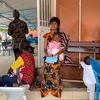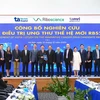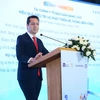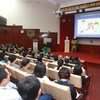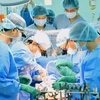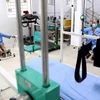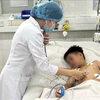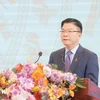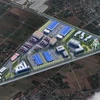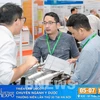Leading Vietnamese paediatrician Prof. Dr. Nguyen Thanh Liem has impressed surgeons worldwide with his huge advancements in endoscopic surgery, applying techniques he invented himself. Report by Radio the Voice of Vietnam (VOV).
I n 1997, Professor Liem received international recognition for his successful research and application of laparoscopic surgery technology to treat Hirschsprung's disease (HD) known as congenital aganglionic megacolon in Vietnam, the first of its kind in Southeast Asia.
His research has been applied at the Central Paediatrics Hospital, promoting its status as one of the world’s leading laparoscopic surgery centres for children. The hospital has also become a regional training centre for laparoscopic surgeons.
Liem recalled how he had the idea of carrying out an endoscopic thoracic operation on infants infected with congenital diaphragmatic hernia (CDH) in 2001, but failed due to limited equipment.
“I introduced my concept to a French professor who later returned to his country and successfully performed such surgery on a 7-month-old infant. One year later, Vietnam was provided with modern medical equipment, enabling us to perform endoscopic thoracic surgery on infants as young as seven months old.
“I wondered if Vietnam could conduct similar surgeries on newborn babies. To do this, I carefully discussed challenges with anesthesia experts to avoid risks,” he said.
The successful endoscopic thoracic surgery on a newborn baby in February 2002 honoured Liem as the pioneer of this difficult technique.
He later completed five research papers on this field which were printed in world renowned publications. He was invited to give lectures and presentations at international workshops in the US, Italy, France, Japan, the Republic of Korea, and many others, promoting his technique worldwide.
International paediatricians consider Liem a leading expert in endoscopic surgical treatment of bile duct cyst and congenital diaphragmatic hernia following his successful surgery on more than 800 cases.
Liem has been asked to compile a chapter on bile duct cyst in paediatric surgery textbooks published in the UK and the US, which was previously done by British and Japanese professors.
Doctors remember Professor Liem for his dedication to scientific research and devotion to the care of his patients.
More than anyone else, he understands the pain child patients suffer, saying he still remembers how his mother died in agony from cancer when he was a student.
The experience inspired him to sit tertiary entrance exams into the Hanoi Medicine University instead of the Hanoi University, nurturing the idea of treating his relatives and saving other lives.
Liem says in 2002 he successfully separated twins Nghia and Dan who were joined in duodenum, diaphragm, pleura, sternum, bile ducts, and intestines in a complex operation of its kind in the world.
A year later, Liem and his foreign colleagues separated twins Cuc and An who were joined in various intestinal organs such as liver, digestive membranes, pericardial diaphragm and sternum. An suffered congenital heart defects, while Cuc had blood tumours in her arm and chest.
The epic nine-hour surgery was a success, and Liem was acknowledged as a leading paediatrician who had performed five conjoined twin surgeries, including two of the most complex in the world.
Since Liem’s endoscopic surgery techniques were introduced, the lives of approximately 5,000 children have been saved annually.
The most important and necessary qualities for any doctor are the desire to learn, explore and research, he said.-VNA
I n 1997, Professor Liem received international recognition for his successful research and application of laparoscopic surgery technology to treat Hirschsprung's disease (HD) known as congenital aganglionic megacolon in Vietnam, the first of its kind in Southeast Asia.
His research has been applied at the Central Paediatrics Hospital, promoting its status as one of the world’s leading laparoscopic surgery centres for children. The hospital has also become a regional training centre for laparoscopic surgeons.
Liem recalled how he had the idea of carrying out an endoscopic thoracic operation on infants infected with congenital diaphragmatic hernia (CDH) in 2001, but failed due to limited equipment.
“I introduced my concept to a French professor who later returned to his country and successfully performed such surgery on a 7-month-old infant. One year later, Vietnam was provided with modern medical equipment, enabling us to perform endoscopic thoracic surgery on infants as young as seven months old.
“I wondered if Vietnam could conduct similar surgeries on newborn babies. To do this, I carefully discussed challenges with anesthesia experts to avoid risks,” he said.
The successful endoscopic thoracic surgery on a newborn baby in February 2002 honoured Liem as the pioneer of this difficult technique.
He later completed five research papers on this field which were printed in world renowned publications. He was invited to give lectures and presentations at international workshops in the US, Italy, France, Japan, the Republic of Korea, and many others, promoting his technique worldwide.
International paediatricians consider Liem a leading expert in endoscopic surgical treatment of bile duct cyst and congenital diaphragmatic hernia following his successful surgery on more than 800 cases.
Liem has been asked to compile a chapter on bile duct cyst in paediatric surgery textbooks published in the UK and the US, which was previously done by British and Japanese professors.
Doctors remember Professor Liem for his dedication to scientific research and devotion to the care of his patients.
More than anyone else, he understands the pain child patients suffer, saying he still remembers how his mother died in agony from cancer when he was a student.
The experience inspired him to sit tertiary entrance exams into the Hanoi Medicine University instead of the Hanoi University, nurturing the idea of treating his relatives and saving other lives.
Liem says in 2002 he successfully separated twins Nghia and Dan who were joined in duodenum, diaphragm, pleura, sternum, bile ducts, and intestines in a complex operation of its kind in the world.
A year later, Liem and his foreign colleagues separated twins Cuc and An who were joined in various intestinal organs such as liver, digestive membranes, pericardial diaphragm and sternum. An suffered congenital heart defects, while Cuc had blood tumours in her arm and chest.
The epic nine-hour surgery was a success, and Liem was acknowledged as a leading paediatrician who had performed five conjoined twin surgeries, including two of the most complex in the world.
Since Liem’s endoscopic surgery techniques were introduced, the lives of approximately 5,000 children have been saved annually.
The most important and necessary qualities for any doctor are the desire to learn, explore and research, he said.-VNA
